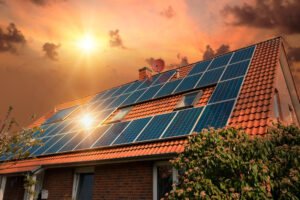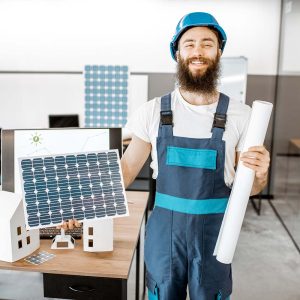Table of Contents
ToggleSolar panels help you save money by reducing your electricity bills and potentially generating income through feed-in tariffs. In this blog, we shall briefly examine the money-saving benefits of solar panels, the factors that influence their efficacy, and the role of location.
Can solar panels save your money
Long-term solar savings
Reduced Energy Bills: Solar panels generate electricity from sunlight, which can offset a significant portion of your home’s electricity consumption. You can reduce reliance on the grid and lower your electricity bills by utilising solar power during the day. The more electricity your solar panels generate, the less you need to purchase from your energy provider, resulting in greater cost savings over time.
Increased Market Value: Installing solar panels can enhance the value of your home. Many homebuyers in Australia recognise the benefits of solar power, including lower electricity bills and reduced environmental impact. As a result, homes with solar panels often appeal to potential buyers, making them more attractive in the real estate market. According to a study by the Lawrence Berkeley National Laboratory, homebuyers are willing to pay an average of $15,000 more for a home with a solar system.
One compelling factor contributing to the increase in value of solar panel-equipped properties is the “solar premium.” This refers to the increase in value attributed to a property with solar panels in contrast to one without them. In certain regions, the solar premium may elevate the home’s value by a notable 4-5%. To illustrate, investing in a solar panel system costing $20,000 could potentially result in a $40,000 increase in the value of your home.
Feed-in Tariffs: Most states and territories across the country have feed-in tariff programs. These programs allow you to sell excess electricity your solar panels generate back to the grid. Depending on the feed-in tariff rates, you can earn credits or receive payment for the surplus electricity you export. This can further offset your electricity costs and provide additional income.
Protection From Future Energy Price Hikes: Solar panels make energy costs more predictable and stable. Unlike traditional energy sources subject to market fluctuations and potential rate increases, the cost of generating electricity from solar panels remains relatively constant once the system is installed. On the whole, when energy prices inevitably rise, the savings you make will help you soften the blow.
Factors that influence solar panel savings
- Solar Panel Quality: The quality and efficiency of solar panels can significantly impact their efficacy. High-quality panels with better conversion rates can generate more electricity from sunlight.
- System Size: The size of your solar panel system determines how much electricity it can generate. A more extensive system can produce more energy, potentially meeting a higher percentage of your electricity needs.
- Orientation and Tilt: The orientation of your solar panels affects their exposure to sunlight. Ideally, panels should face north in the Southern Hemisphere to receive maximum sunlight. The tilt angle should also be optimised based on your location’s latitude to maximise solar energy absorption.
- Shading: Shading from trees, buildings, or other obstructions can significantly reduce the efficiency of solar panels. It’s important to ensure that your panels are installed in an area with minimal shade to maximise their output.
How your location can affect your solar power production
- Sunlight Availability: The amount of sunlight your location receives directly affects the efficacy of solar panels. Generally, regions with higher solar irradiation levels (keep in mind that Perth is the sunniest capital in Australia) are more conducive to solar power generation.
- Climate: Climate conditions, including temperature and weather patterns, can impact solar panel performance. Extreme heat can slightly reduce panel efficiency, while cooler temperatures can increase efficiency.
- Latitude: Your location’s latitude influences the angle at which solar panels should be installed to capture the most sunlight. Adjusting the tilt angle according to your latitude can optimise energy production.
How to estimate your solar savings
There are a number of factors that will affect the overall savings you make. Let us take a look at them:
- Understanding your current electricity usage: Review your electricity bills to determine your average monthly or annual electricity consumption in kilowatt-hours (kWh). This information will serve as a baseline for calculating potential savings.
- Assessing your rooftop solar power potential: Evaluate the suitability of your roof for solar panel installation. Consider factors such as roof orientation, tilt, shading from trees or nearby buildings, and available roof space. North-facing roofs typically receive the most sunlight in Australia.
- Determine the system size: The size of your solar panel system will depend on your electricity consumption, available roof space, and budget. A larger system can generate more electricity but may require a higher upfront investment.
- Calculate solar energy production: Use online solar calculators or consult with solar installers to estimate the solar energy production of your system. They consider factors like location, roof orientation, tilt, shading, and panel efficiency. This estimate will provide an approximation of the electricity your solar panels can generate annually.
- Consider your feed-in tariff: If your state or territory offers a feed-in tariff program, determine the rate at which you can sell excess electricity back to the grid. This rate can vary depending on your location and the program you are enrolled in.
- Estimate electricity savings: Calculate the portion of your electricity usage that can be offset by solar energy. Subtract the estimated solar energy production from your annual electricity consumption. This will give you an idea of how much electricity you will still need to purchase from the grid.
- Consider system costs and payback period: Determine the upfront cost of installing the solar panel system, including equipment, installation, and any additional expenses. Divide this cost by the annual financial savings to estimate the payback period—the time it takes to recover your initial investment through energy savings. Additionally, research available government incentives, rebates, and tax credits that can reduce the upfront cost of installing solar panels. Consider these incentives to determine your net investment and adjust your savings estimation accordingly.
There’s a small caveat to be considered here – the major chunk of your savings lies not in selling unused power back to the grid but in making use of it. Synergy currently offers 10c / kWh for energy exported from 3 p.m. to 9 p.m. and 2.25c / kWh for energy exported at all other times in accordance with DEBS buyback rates. Contrast this to the cost you’d pay for buying power from it, i.e. approximately 30c/kWh. By using the units you produce as opposed to selling them to Synergy, you make massive savings whilst being protected from sudden hikes.
What are some of the biggest misconceptions regarding solar panels?
Too expensive!
A common misconception is that solar power is prohibitively expensive. While an upfront cost is associated with installing solar panels, the prices have significantly decreased over the years by around 30-40%. Additionally, various government incentives, rebates, and financing options are available to help reduce the initial investment. There is, for instance, the Small-scale Renewable Energy Scheme (SRES), a financial incentive that helps individuals and small businesses to purchase and install their solar energy systems. Solar power can be a cost-effective option when considering the long-term savings on electricity bills and potential income from feed-in tariffs.
Not reliable!
Another misconception is that solar power is inefficient and unreliable. However, solar panel technology has advanced significantly, and modern panels have high conversion efficiency. While solar energy production is dependent on sunlight, solar panels can still generate electricity on cloudy or overcast days. Additionally, battery storage systems can be installed to store excess energy for use during low-sunlight periods, increasing reliability. It all comes down to what kind of solar panel you use- monocrystalline, polycrystalline, and thin film.
- Monocrystalline silicon solar panels: These are the most efficient type of solar panel, but they are also the most expensive.
- Polycrystalline silicon solar panels: These are less efficient than monocrystalline silicon solar panels, but they are also less expensive.
- Thin-film solar panels: These are the least efficient type of solar panel, but they are also the most lightweight and flexible.
Moreover, a majority of solar panels in Australia utilise crystalline silicon, employing advanced photovoltaics to optimise the conversion of solar energy into electricity. Crystalline silicon solar panels are the most common type of solar panel in Australia. They are made from silicon wafers, which are cut from a single crystal of silicon. Crystalline silicon solar panels are very efficient and can convert up to 22% of the sunlight they receive into electricity. Additionally, these panels are treated with an anti-reflective coating, enhancing their ability to capture sunlight.
High Maintenance!
There is a misconception that solar panels require frequent and costly maintenance. Solar panels are durable and have no moving parts, reducing the need for regular maintenance. Occasional cleaning to remove dust or debris and inspections to ensure optimal performance are generally sufficient. Additionally, reputable solar panel manufacturers provide warranties that cover panel performance for 20 to 25 years.
Only makes sense for homeowners!
Some people believe that solar power is only beneficial for homeowners. However, renters, businesses, and communities can also benefit from solar power through various arrangements like power purchase agreements (PPAs) or community solar projects. These options allow non-homeowners to access the benefits of solar energy without owning the property.
Conclusion
As time goes on and energy prices fluctuate, the need for going solar and establishing one’s energy independence becomes more and more pressing. A lot of white noise abounds, downplaying the important role that solar will play not just towards helping us cope with a volatile energy market but also towards ushering us into a greener, more sustainable future.
At West Coast Solar, we believe in the long-term good that solar power at large can bring to every household and business in Perth. With our trusted workmanship and focus on customer satisfaction at the forefront of what we do, we’ve got the fantastic long-term benefits of solar energy to more than 2000+ homes and businesses. We adhere to the highest standards, only purchasing solar panels from reputed manufacturers such as LG, Jinko, Suntech, Leapton, Sunpower, Canadian Solar, Astronergy, Risen, Longi, TW Solar, Sunman, Ulica, Eging PV, AE Solar, REC, JA, Seraphim, Trina, and Hyundai. We have also been accredited by the Clean Energy Council.
So whenever you intend to go solar, look no further than West Coast Solar!
Solar panels can be worth it for many homeowners, depending on their specific circumstances. Solar panels can help reduce electricity bills, provide long-term cost savings, increase the value of your home, and contribute to a greener and more sustainable future. However, the financial benefits of solar panels depend on factors such as your electricity consumption, available sunlight, government incentives, and installation costs. It’s recommended to evaluate your energy needs, research available incentives, and consult with reputable solar installers to determine if solar panels are a worthwhile investment for you.
The cost of installing solar panels can vary depending on several factors, including the size of the system, the quality of the panels, your location, and any additional components or features you may choose. Prices have been on the dip, however, so whereas installing a good 6.6kW system cost you around $6000 a couple of years ago, it has come down to around $5400 now. It is best to seek a quote from the solar panel installer themselves.
The installation time for solar power can vary depending on factors such as the installation’s complexity, the system’s size, and the solar installer’s availability. On average, residential solar panel installations in Australia can take anywhere from a few days to a few weeks. This includes the time required for site assessment, obtaining necessary permits, installation of the panels and associated equipment, and grid connection. The solar installer can provide a more precise timeline based on your specific installation requirements.
When appropriately installed by qualified professionals, solar panels are safe to use on your rooftop. Solar panels undergo rigorous testing and certification processes to ensure their safety and compliance with industry standards. Reputable solar installers follow strict installation guidelines and take precautions to ensure the panels are securely mounted and properly connected to your electrical system. It’s important to hire a licensed and experienced solar installer to ensure your solar panel system’s safe and reliable installation. Regular maintenance and inspections are also recommended to ensure continued safety and optimal performance.

Wade Rose
Wade Rose, an accomplished electrician with a career spanning from the age of 18, has smoothly navigated the dynamic terrain of the energy sector. In 2008, he made a notable shift towards renewable energy, and by 2015, Wade's focus had firmly turned towards solar technologies. Over the years, he has refined his expertise in Residential and Commercial Photovoltaic (PV) and Battery systems, significantly advancing sustainable energy solutions. Wade's dedication to innovation and excellence has garnered recognition from colleagues and customers. Beyond his professional endeavours, he enjoys riding motorcycles, boat rides, camping, fishing, exploring Australia and cherishing moments with his family. Wade Rose brings a wealth of experience and a genuine passion for sustainable energy to the forefront, making him an invaluable leader for navigating the complexities of EAT implementation.



